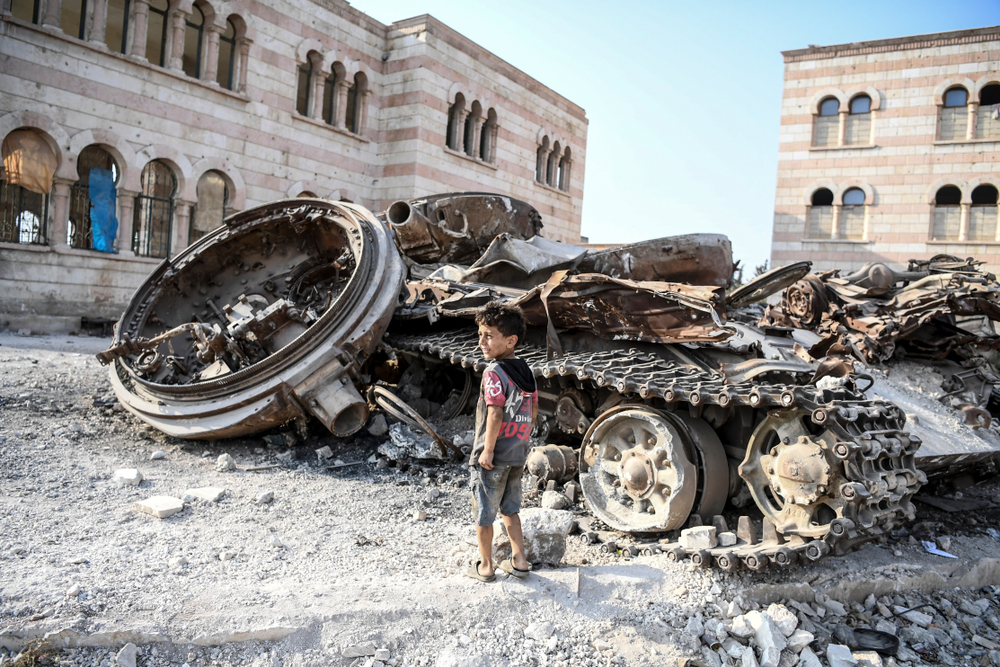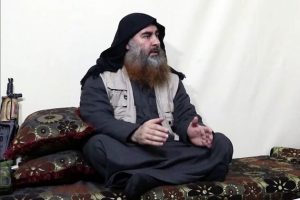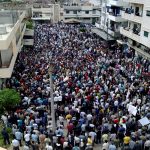by Helena Cobban
In the northwest Syrian province of Idlib, three million civilians find themselves at the vortex of large-scale battles as the Syrian government and its allies seek to retake the area from the rebel forces that have controlled the region for nearly eight years. Idlib is now the beleaguered last redoubt within Syria of the armed rebellion that arose in the country in summer 2011.
That much everyone who reads the U.S. corporate media is probably aware of. But what most of the corporate media have notably not reported is that the rebel forces that control Idlib are strongly dominated by the al-Qaeda affiliate known as Hai’at Tahrir al-Sham (HTS) and its allies. This fact explains the political impasse over Idlib and the searing dilemma that genuine (as opposed to al-Qaeda-linked) humanitarian groups face in responding to the mounting crisis there. Also, a high proportion of the HTS forces are the last remnants of the massive wave of foreign fighters who flocked to northern Syria after 2011.
One example of the corporate media’s flawed reporting was this May 30 piece in The New York Times in which Carlotta Gall and Huweida Saad wrote at length about the humanitarian crisis in Idlib. But they made zero mention of the domination that HTS and its allies exert over the situation there—including over the activities of all the aid groups in the area.
This article on Idlib was reported from Ankara, Turkey (by Gall) and Beirut, Lebanon (by Saad.) But it does not explain that the reason why no Western reporters are able to go to Idlib is because of the many killings and other attacks Western reporters have suffered at the hands of HTS and its allies in different parts of Syria. Nor does it explain that, because of their distance from the scene, these reporters were unable to independently verify the accounts of events inside Idlib their informants provided.
The overall thrust of Gall and Saad’s at-distance reporting—as with so many similar pieces in the corporate media in recent weeks—was that the Syrian government and its Russian allies were just wantonly attacking civilian facilities in Idlib. It made no mention of Syrian or Russian forces attacking military targets in Idlib or of the casualties the HTS-dominated fighters inside the enclave had inflicted on civilians in neighboring government-held areas.
The Gall/Saad article does make a short reference, low down in the piece, to the key agreement the Russian and Turkish presidents reached last September to allow for de-escalation in the Idlib region. (Turkey has considerable control over all the rebels in Idlib because it commands all the routes through which they can receive aid—or weapons—from the outside world. For its part, Russia is a key military-political ally of the Syrian government.)
Gall and Saad fail to spell out, however, that under the September agreement Turkey expressly agreed to intervene in Idlib to pull HTS and its allies back from the frontline and eventually from the whole of the enclave. Russia agreed, in return, to hold its Syrian allies back from attacking the rebel positions in Idlib. Turkey has not done what it promised. In early May, Turkey’s non-performance of the agreement prompted Syria and Russia to resume their attempts to reassert Syrian government control over Syria’s national territory in Idlib through military means.
Turkey is understandably reluctant, Gall and Saad report, to countenance a collapse of the rebel position in Idlib that could send tens of thousands of the province’s current residents fleeing as refugees into Turkish territory. But they don’t spell out that many of those fleeing would almost certainly be HTS fighers—including that large proportion of HTS fighters who aren’t Syrians at all, but foreign takfiri (extremist-jihadi) fighters from a variety of countries, most of whose governments do not want them to return.
Turkey does, however, bear considerable responsibility for the presence in Syria of the foreign fighters (and in many cases, also their families). From 2011 through late 2014, it actively facilitated the transfer of those takfiris and their weapons and money into Syria, in pursuit of the military campaign that it, Saudi Arabia, Qatar, the United States, and others launched to topple Bashar al-Assad’s government.
Since 2011, Turkey has suffered considerable blowback from that regime-change campaign against Syria. Much of this blowback came from the Kurdish forces—Washington’s recent allies—who are centered in the northeast of Syria. They are closely tied to the anti-Ankara insurgents of the Turkish-Kurdish “PKK” who have long been active across eastern Turkey. But Turkey has also suffered blowback from several of the border-straddling pro-al-Qaeda networks whose anti-Assad activities in Syria Turkish security services have often very actively aided.
The Problem of Resettlement
The Turkish government doubtless views the prospect of thousands of homeless, disgruntled, but well-armed foreign jihadis pouring into Turkey from Syria with some dread. This complex question of how to handle foreign takfiris whose forces have been defeated in Syria already came up in the context of Islamic State fighters (and their families) after the collapse, earlier this year, of that force’s last outposts in northeastern Syria. The HTS/Qaeda takfiris who dominate Idlib have not yet been defeated. But already, their domination of the situation on the ground in Idlib is causing grave headaches for everyone concerned about the future—or indeed, the present situation—of all the province’s people.
The Washington Post’s Editorial Board at least recognizes that there is a problem. In a May 17 editorial, it described the terms of last year’s Russia-Turkey agreement and noted that Turkey “has failed to disarm or expel the militants” of HTS. But the conclusion it drew was vague and unrealistic: “While the menace posed by the jihadists must be addressed, a military solution led by Assad and Russian forces is unthinkable… No durable peace in Syria is likely until the bonds linking Russia, Iran and the Assad regime are broken.”
Meanwhile, the HTS/Qaeda rebels’ continued domination of most of Idlib poses heartrending challenges for all the genuine humanitarian-aid organizations that seek to provide aid to the province’s three million residents. Tragically, the aid flows across the border from Turkey into Idlib are always, once they cross the international border, subject to diversion by the rebel fighters, who then use their control over these vital goods to increase their control over the province’s population.
After 2011, a number of big Western aid NGOs became very involved in running aid projects in rebel-held areas in Syria—often under contracts from USAID. More recently, USAID has sanctioned many of these NGOs for allowing diversions of their aid or their finances either to rebel-connected networks inside Idlib or to corrupt Turkey-based individuals (perhaps linked to the HTS/Qaeda networks.) These NGOs include International Rescue Committee and International Medical Corps, along with Catholic Relief Services, Save the Children in the UK, and GOAL in Ireland.
The aid flowing across Turkey’s border with Idlib has amounted to hundreds of millions and ultimately billions of U.S. dollars. The difficulty of monitoring the work of staff members in distant parts of Turkey and Idlib made the whole field ripe for numerous forms of corruption, including the diversion of aid by the takfiris.
This is by no means a new development. The excellent Swedish reporter Aron Lund was reporting in depth on it in mid-2017—but only in the UN-linked newsletter The New Humanitarian. Meanwhile, the big Western media have preferred to turn a blind eye to the story of this diversion of aid flows by the takfiris—most likely because it challenges the preferred narrative of the “innocent civilians” and “heroic rebels” of Idlib being at the mercy only of the “evil” Syrian and Russian governments.
Inside Idlib
Idlib’s present population includes, of course, a strong majority of innocent civilians. But it also includes an estimated 10,000-plus well-armed takfiri fighters, a large portion of whom are not Syrians. Idlib’s civilians do undoubtedly, along with the fighters, suffer from the military activities of the Syrian government and its allies. But the takfiri fighters, who worry that if they lose in Idlib they’ll have nowhere else to go, also ruthlessly use civilians as hostages.
This is not a new dilemma. Twenty-five years ago, after the Rwandan genocidaires were defeated inside their own country, they fled to Eastern Congo. They persuaded a large portion of the country’s majority-Hutu population to flee with them to avoid the quite predictable vengeance of the victorious Tutsi forces. Very speedily, Hutu refugees established massive camps in the forests of Congo controlled by the genocidaires’ militia. At that point, the aid organizations involved were the big UN agencies like UNHCR, the World Food Program, and UNICEF. They agonized for years over the degree to which the genocidaires continued to divert aid and use it as a lever to maintain their control over the civilians. Only when Rwanda’s rebuilt military went into Congo and physically defeated the genocidaires—very violently and corruptly—was the problem solved.
In Idlib, under the agreement Turkey and Russia concluded last September, Turkey is supposed to go into the troubled province and end the takfiris’ control of the area. Until that control ends one way or another, the noncombatants of Idlib will continue to suffer. But it is completely impossible to understand the plight of Idlib’s noncombatants or the broader geopolitics of what is happening in Syria unless journalists and others clearly describe the power dynamics within the rebel-held territory.






Brilliant Ms. Cobham.
Absolutely spot on analysis.
Earlier today I sent this to the Wash Post. “The Post’s misunderstanding of what is going on in Idlib Syria is shocking. For years Turkey has in Idlib armed and protected the very Islamist extremists the US has been fighting. The Assad regime has succeeded to restore Syrian sovereignty across most of the country – against the Islamist extremists the US had been unable to organize or control back in 2012-2015.
Why not ask Turkey when and how they intend honor their commitment to disarm these thousands of fanatics who have nowhere else left to go now but – Turkey? Is Russia supposed to just stop and allow 3 million Syrians to live under what surely will again be declared the Islamic Caliphate.”
Next piece you should address is how and why Turkey did these self-defeating things?
Cobban uses the term takfiri to describe Islamist fighters in this article and in a previous article she refers to them as Contras. One can certainly understand why she would have such animosity toward al-Nusra but in an earlier article she wrote (in italics) that Assad “was not nearly as widely loathed by his people”. So, it is pretty obvious that she regards him as a lesser evil. That being said, when was the last time these “takfiris” were caught bombing hospitals, using poison gas, carrying out starvation sieges, or killing tens of thousands of prisoners? I guess you are entitled to carry out such measures in a “war on terror”, especially when the “Contras” show such unaccountable hatred toward a family dynasty that runs a mafia state.
Louisproyect
What would have been your recommended resolution to the Civil War in Syria?
In England, in US, and in Spain the civil wars ended when one side crushed the other side’s will to resist.
The Second World War ended when the axis powers were crushed through the application of similar methods that you describe.
What is your alternative for Mr. Assad to have destroyed the will of rebels to fight?
How do you make, rationally, a distinction between civilian and military targets?
I don´t understand why there are significant numbers of truly neutral civilians in Idlib at this point. For two years they must have watched as convoys of AQ HTS and ISIS jihadists were shipped there from all over Syria as they negotiated pull-outs as an alternative to being obliterated.
Even if you had been born and bred in Idlib, you would need to be insane to stay there at this time. Especially after the last 6 mo.
There is no option but to put the squeeze on Turkey (who obviously cannot or will not deliver their side of the deal) and proceed with the clear out of Idlib.
Clear out the Pariah US of A after that. Afghanistan style if necessary.
Be careful what you wish for. The Syrians wanted freedom and liberty. What they got was Saudi/UAE/Turkish/US/Israeli financing and facilitation of all the extremist they could get their hands on to go Syria and kill as many people as they could.
All of our hearts go out to the people of Iblid, Raqqa, Hama, Aleppo, etc. – but this is at least what some of them wanted and the rest were forced in. As FYI remarked earlier, there is no solution other than a finalist military confrontation. This generation will suffer, but maybe they can remind future generations and others about the pain that they endured and not to be wary of the Saudi’s bearing gifts – like weapons. The war would have been over long ago with significant less suffering if outside forces had no injected the huge cash of weapons into Syria.
The only good news for the US is that our partners the Saudi/UAE/Israeli did not drag us into another war.
Excellent article, thank you for writing it.